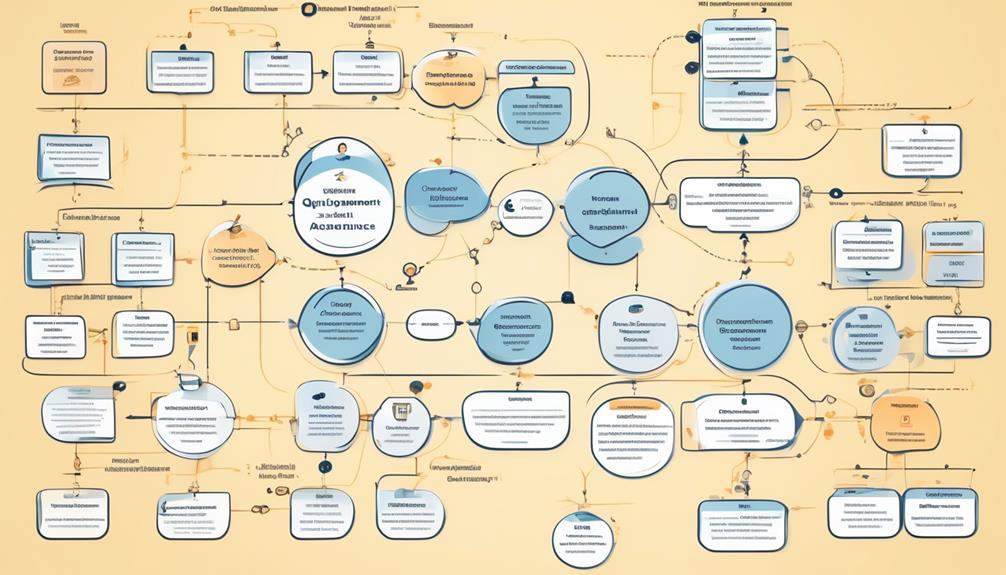Software Quality Assurance (SQA) is essential in guaranteeing software meets particular standards and operates correctly. Through the use of established techniques and top practices, software quality can be improved, resulting in more efficient SQA processes. This article seeks to explore various crucial SQA methodologies and tactics required for achieving success in software development projects.
Key Takeaways:
- Understand different software development methodologies such as Agile and Waterfall to adapt SQA approach accordingly.
- Master the fundamentals of software testing, including different testing methodologies and test levels.
- Utilize tools and create testing environments for efficient and accurate testing.
- Build a strong quality foundation by familiarizing yourself with quality assurance principles and best practices in software testing.
- Develop comprehensive test plans and strategies that align with project objectives and scope.
Understanding Software Development Processes
To excel in SQA, it is essential to have a solid understanding of software development processes. Familiarize yourself with different software development methodologies, such as Agile and Waterfall. Understanding how development teams work is crucial for effective testing. This knowledge will enable you to adapt your SQA approach to different software projects and teams.
“To be successful in SQA, we need to comprehend the intricacies of software development. By gaining knowledge of various methodologies like Agile and Waterfall, we can align our testing processes with the development team’s approach. This results in enhanced collaboration and optimized software quality.”
| Software Development Methodologies | Description |
|---|---|
| Agile | An iterative approach that focuses on flexibility, collaboration, and quick delivery of working software. It emphasizes adaptability to changing requirements and promotes regular communication among development team members. |
| Waterfall | A sequential approach that follows a linear progression through the different phases of software development, including requirements gathering, design, development, testing, and deployment. Each phase is completed before moving to the next. |
To effectively carry out software testing, it is beneficial to understand the development team’s methodology. Agile methodology allows for continuous feedback and adaptability, which is well-suited for projects with evolving requirements. On the other hand, the Waterfall model ensures a structured and planned approach, ideal for projects with well-defined and stable requirements. By familiarizing ourselves with these methodologies, we can align our testing efforts accordingly and contribute to successful software development.
An image illustrating the different software development methodologies:

Mastering Testing Fundamentals
Knowing the fundamentals of software testing is essential for a successful SQA career. To ensure that software meets the highest standards of quality and performance, software testers must be well-versed in various testing methodologies and techniques. Let’s explore some of the key concepts that form the foundation of effective software testing.
Testing Methodologies
Testing methodologies are approaches or strategies used to conduct software testing. By understanding and utilizing different methodologies, software testers can design and execute comprehensive tests to identify potential defects and ensure the software functions as intended. Here are three common testing methodologies:
- Black Box testing: This testing method focuses on testing the software’s functionality without considering its internal structure. Testers evaluate the software’s behavior by providing input and observing the output, without knowing how the system processes the input.
- White Box testing: In contrast to Black Box testing, White Box testing examines the internal structure and logic of the software. Testers have access to the source code and use their knowledge of the software’s internals to design tests that thoroughly test its components and logic.
- Grey Box testing: Grey Box testing combines elements of both Black Box and White Box testing. Testers have partial knowledge of the internal structure, allowing them to design tests that target specific areas of the software.
Test Levels
Test levels are stages of testing that ensure comprehensive coverage and identify defects at different levels of the software’s development. By conducting tests at each level, software testers can ensure that the software meets quality standards before moving on to the next stage. Here are four common test levels:
- Unit testing: This level focuses on testing individual components or modules of the software to ensure that they function as intended.
- Integration testing: Integration testing verifies the interaction between different modules or components of the software to ensure that they work together seamlessly.
- System testing: System testing evaluates the software as a whole, testing its functionality and performance in a complete, integrated system environment.
- Acceptance testing: Acceptance testing is the final stage of testing, where the software is evaluated against the business requirements and user expectations to determine if it is ready for release.
By mastering different testing methodologies and understanding test levels, software testers can effectively design and execute tests that ensure the software’s quality and reliability. Let’s put these concepts into practice in the next section as we delve deeper into the world of software testing.

Building a Strong Quality Foundation
When it comes to software testing, quality assurance principles lay the foundation for success. By understanding and implementing these principles, we can ensure that our software meets the highest standards of quality. Let’s explore some key quality assurance principles and best practices in software testing.
One of the fundamental quality assurance principles is to have clear and well-defined quality standards in place. These standards act as benchmarks for measuring the quality of our software. By adhering to these standards, we can maintain consistency and improve the overall quality of our products.
The Importance of Best Practices in Software Testing
In addition to quality standards, incorporating best practices in software testing is essential for building a strong quality foundation. Best practices provide proven approaches and techniques that have been effective in delivering reliable and high-quality software.
By following best practices, we can identify potential issues early in the development cycle, prevent defects from reaching production, and ensure that our software functions as intended.
Some best practices in software testing include:
- Creating comprehensive test plans and strategies that align with project objectives and scope
- Designing test cases that cover both positive and negative scenarios
- Implementing rigorous testing techniques, such as black box and white box testing
- Performing thorough system and acceptance testing
By incorporating these best practices, we can establish a robust testing process and increase the chances of delivering high-quality software to our users.
Implementing Quality Assurance Principles
To implement quality assurance principles effectively, it’s crucial to have a clear understanding of the software development lifecycle and the role of quality assurance within it. Quality assurance should be an integral part of every stage of the development process, from requirements gathering to deployment.
We should also prioritize continuous improvement in our quality assurance process. This involves learning from past experiences, conducting retrospective analyses, and making adjustments to improve future testing efforts.

Manual and Automation Testing
Both manual and automation testing are integral parts of Software Quality Assurance (SQA). We utilize these two approaches to ensure the effectiveness and efficiency of software testing processes.
Manual Testing
In manual testing, we execute test cases manually to validate software functionality. By performing tests step by step, we can thoroughly evaluate the software and identify any defects or issues. This hands-on approach allows us to accurately report defects and manage them effectively, ensuring the software meets the required standards of quality.
Automation Testing
To improve efficiency and test coverage, we also utilize automation testing. We use automation testing tools like Selenium to automate repetitive test cases and maximize our testing efforts. By automating these tests, we reduce the time and effort required for their execution, allowing us to focus on other critical aspects of the SQA process.
One key benefit of automation testing is its ability to execute tests consistently and repeatedly, ensuring accurate and reliable results. Additionally, automation testing enables us to perform regression testing more efficiently. Regression testing helps us identify if any new changes or updates to the software have affected its existing functionality and stability.
To summarize, manual testing allows us to thoroughly evaluate software functionality, report defects accurately, and manage them effectively. Automation testing, on the other hand, helps us improve efficiency, maximize test coverage, and streamline the testing process. By combining these two approaches, we ensure comprehensive testing and deliver high-quality software.
| Manual Testing | Automation Testing |
|---|---|
| Executed manually | Executed using automation testing tools |
| Thoroughly evaluates software functionality | Efficiently automates repetitive test cases |
| Accurately reports defects | Improves efficiency and test coverage |
| Effectively manages defects | Enables regression testing |
Documentation and Reporting
In software testing, maintaining comprehensive test documentation is essential to ensure a smooth and effective testing process. With proper documentation, we can communicate testing results, record test cases, plans, and other crucial information, facilitating collaboration and issue resolution.
One important aspect of test documentation is creating test reports. These reports serve as a summary of the testing activities, highlighting the key findings, test coverage, and any identified defects. They provide stakeholders with a clear understanding of the testing progress and help in decision-making.
In addition to test reports, it is also important to create test summaries. Test summaries provide a high-level overview of the testing efforts, outlining the objectives, scope, and outcomes of the testing process. They help stakeholders quickly grasp the overall status and impact of the testing phase.
By documenting test cases, test plans, and other relevant information, we ensure a complete record of the testing process, helping us track and analyze the results effectively. Good documentation practices enable us to identify trends, patterns, and areas for improvement, ensuring continuous enhancement of the SQA process.
“Documentation is the bridge that connects testing to the rest of the development process, enabling effective communication and collaboration.”
We must maintain clear and well-structured test documentation to foster efficient collaboration among team members, allowing everyone involved to contribute effectively to the quality assurance process.
Additional Skills for Success
In addition to mastering the core skills required for Software Quality Assurance (SQA), there are several additional skills that can greatly contribute to your success in this field. By acquiring these skills, you can broaden your expertise and tackle a wide range of testing challenges.
Programming Skills
To excel in automation testing, it is essential to acquire programming skills in languages such as Python or Java. These languages provide the necessary foundation for creating robust and efficient automated test scripts, increasing productivity and accuracy in testing processes.
API and Web Services Testing
With the increasing reliance on web applications and services, having knowledge and experience in API and web services testing is crucial. This skill allows you to effectively validate the interactions between different software components, ensuring that they function seamlessly and deliver the expected results.
Performance Testing
Performance testing is vital for applications and systems to meet user expectations and handle a large number of users without performance degradation. By understanding the concepts and tools related to performance testing, you can identify performance bottlenecks, optimize application performance, and deliver an exceptional user experience.
Security Testing
With the ever-growing threat landscape, security testing is essential to ensure that software systems are protected from vulnerabilities and potential attacks. By learning security testing techniques and tools, you can identify security weaknesses, assess potential risks, and implement effective security measures to protect valuable data and preserve user trust.
Database Testing
Database testing is crucial for verifying the accuracy, integrity, and performance of data storage and retrieval systems. By gaining proficiency in database testing techniques and tools, you can ensure that databases are properly designed, function efficiently, and maintain data integrity under various scenarios.
DevOps
DevOps practices have become integral to software development and SQA. By familiarizing yourself with DevOps principles and tools, you can facilitate seamless collaboration between development and operations teams, automate testing processes, and deliver high-quality software in an agile and efficient manner.
Cloud Computing
Cloud computing has revolutionized the software industry, providing scalable and flexible infrastructure for application deployment and testing. By understanding cloud computing concepts and gaining experience with cloud-based testing tools and environments, you can effectively leverage the benefits of cloud computing and enhance your testing capabilities.
Mobile Testing
With the widespread adoption of mobile devices, mobile testing has become a critical component of SQA. By acquiring the skills and knowledge required for mobile testing, you can effectively ensure that mobile applications and websites function correctly across various devices, operating systems, and network conditions.
By investing time and effort into acquiring these additional skills, you can strengthen your SQA expertise, expand your career opportunities, and contribute to the successful delivery of high-quality software.
Agile and Scrum Methodologies
In the world of software development, Agile methodologies, such as Scrum, have gained significant popularity due to their flexibility and iterative approach. As SQA professionals, it is essential for us to adapt to these methodologies and actively participate in Scrum ceremonies to ensure the successful delivery of high-quality software.
In Agile methodologies, the development process is divided into smaller, manageable timeframes known as sprints. During each sprint, the team works collaboratively to deliver a potentially shippable product increment. To align with the development team, we need to foster effective communication and continuously exchange feedback.
An integral part of Agile and Scrum is continuous testing. Rather than leaving testing until the end of the development cycle, continuous testing emphasizes testing throughout the development process. This approach allows for fast feedback and early defect detection, ensuring that issues can be addressed promptly.
By embracing Agile and Scrum principles, we can effectively align our SQA efforts with the development team. This collaboration enhances the overall software quality by promoting transparency, adaptability, and iterative improvements. Our participation in Scrum ceremonies, such as the daily stand-up, sprint planning, sprint review, and retrospective, enables us to actively contribute to the project’s success.
Implementing Agile and Scrum methodologies requires a shift in mindset and a willingness to embrace change. It empowers us to deliver high-quality software iteratively, respond to customer needs more efficiently, and accommodate evolving requirements.
Benefits of Agile and Scrum Methodologies
There are several benefits to adopting Agile and Scrum methodologies in SQA:
- Increased collaboration and communication
- Flexibility to accommodate changing requirements
- Fast feedback and early defect detection
- Improved transparency and visibility
- Enhanced team engagement and satisfaction
By leveraging these methodologies, we can overcome the challenges associated with traditional development approaches and deliver software that meets the evolving needs of the stakeholders.
Comparison of Agile and Waterfall Methodologies
| Agile | Waterfall |
|---|---|
| Divided into sprints | Sequential phases |
| Flexible and adaptive | Rigid and sequential |
| Emphasizes collaboration | Minimal collaboration |
| Iterative approach | Linear approach |
Table: Comparison of Agile and Waterfall methodologies in software development.
As illustrated in the table above, Agile and Waterfall methodologies have distinct characteristics. While Waterfall follows a sequential, step-by-step approach, Agile embraces flexibility and adaptability through iterative development.
“Agile methodologies, like Scrum, allow us to embrace change and continuously improve our software development process.”
– John Maxwell
By understanding the differences between these methodologies, we can choose the most suitable approach based on the project’s requirements and constraints.
Conclusion
In summary, Software Quality Assurance (SQA) is a crucial aspect of software development that ensures the delivery of high-quality, reliable software. By implementing various SQA methodologies and techniques, software testers can contribute to the success of software development projects.
To excel in SQA, it is important to build a strong foundation by understanding software development processes and mastering testing fundamentals. Additionally, leveraging the right tools and environments, such as version control systems and testing databases, is essential for efficient and accurate testing.
Continuous learning and development of additional skills, such as programming, API and web services testing, and performance testing, can further enhance the capabilities of SQA professionals. Embracing Agile and Scrum methodologies, along with continuous testing practices, enables testers to align with development teams and deliver high-quality software iteratively.
By embracing a holistic approach to SQA, staying updated with industry trends, and continuously improving skills, software testers can consistently contribute to the success of software development projects. SQA professionals are key players in ensuring software quality and reliability, making a significant impact on the overall success of software products and services.
FAQ
What is SQA?
SQA stands for Software Quality Assurance. It involves implementing methodologies and best practices to ensure software meets specified requirements and functions as expected.
Why is it important to have a solid understanding of software development processes for SQA?
Understanding software development processes is crucial for effective testing. It allows us to adapt our SQA approach to different software projects and teams.
Why is it important to study different testing methodologies and levels for SQA?
Studying different testing methodologies and levels helps us design and execute comprehensive tests to identify and address software defects.
Why is it important to be proficient in using testing tools and creating test environments for SQA?
Being proficient in using testing tools and creating test environments helps streamline the SQA process and ensures efficient and accurate testing.
Why is it important to understand quality assurance principles for SQA?
Understanding quality assurance principles helps us implement standards and best practices in software testing, leading to high-quality software.
Why is effective test planning and strategy vital for SQA?
Effective test planning and strategy ensure a systematic and thorough approach to testing, aligning with project objectives and scope.
Why are both manual and automation testing significant in SQA?
Manual testing helps validate software functionality and report defects accurately, while automation testing improves efficiency and coverage.
Why is thorough test documentation important in SQA?
Thorough test documentation facilitates collaboration, effective communication, and issue resolution throughout the testing process.
What additional skills are important for success in SQA?
Additional skills include programming skills, API and web services testing, performance testing, security testing, database testing, DevOps practices, cloud computing, and mobile testing.
Why is it important to work effectively within agile and Scrum methodologies for SQA?
Working effectively within agile and Scrum methodologies allows for continuous testing, fast feedback, and early defect detection, contributing to high-quality software.
How can SQA professionals contribute to the success of software development projects?
By understanding and implementing various SQA methodologies, building a strong foundation, leveraging tools and environments, and continuously developing and improving skills, SQA professionals play a crucial role in ensuring software quality and reliability.









